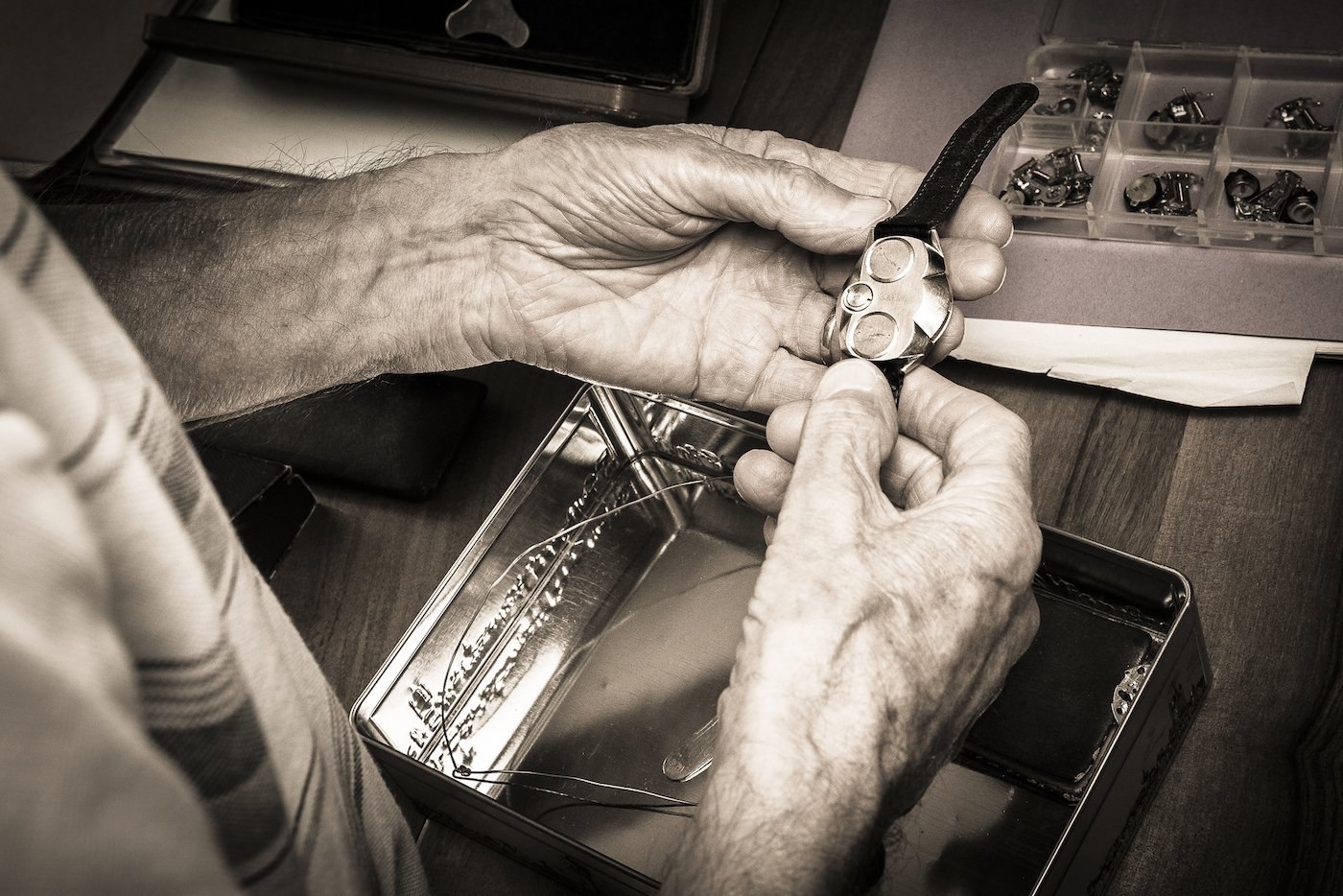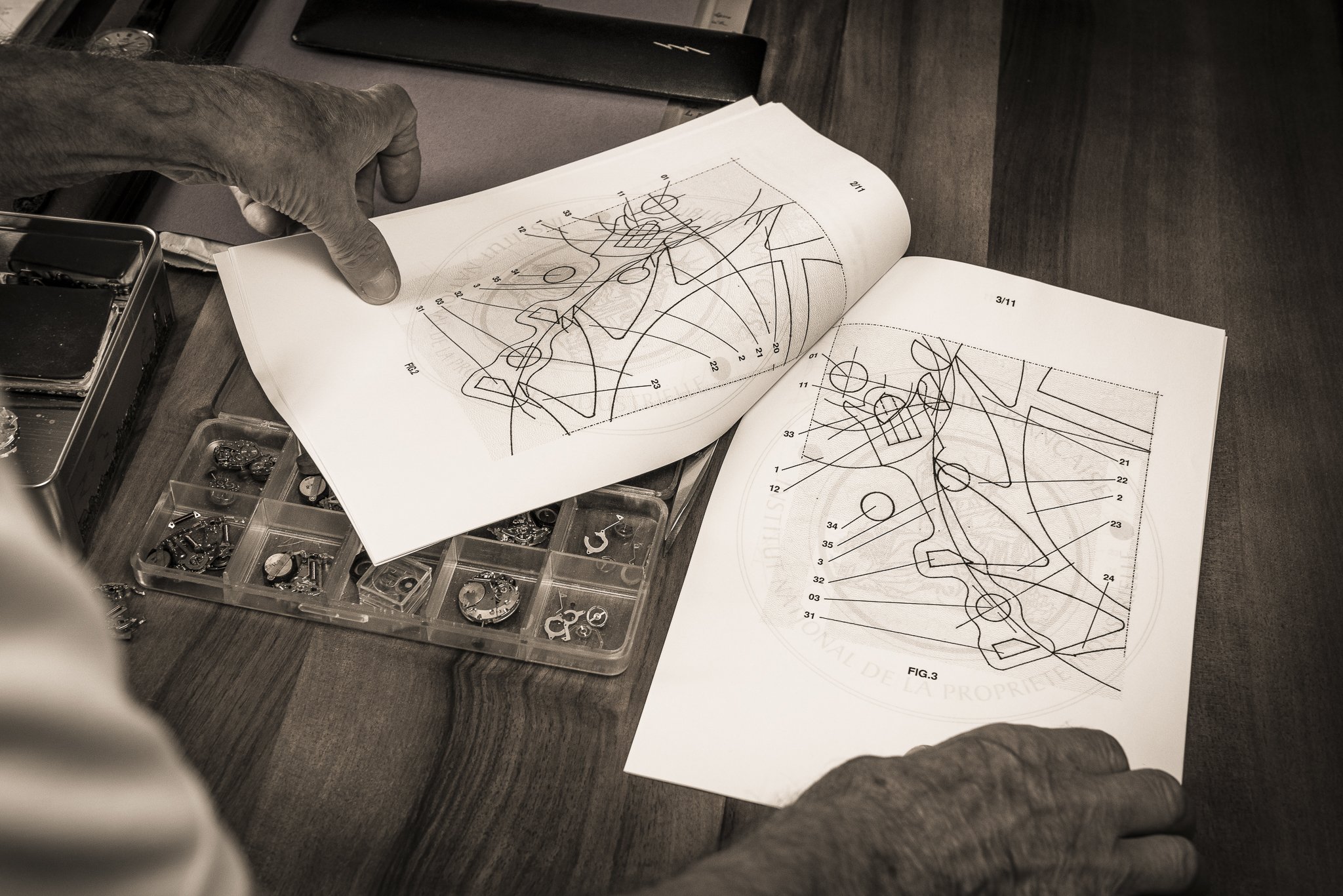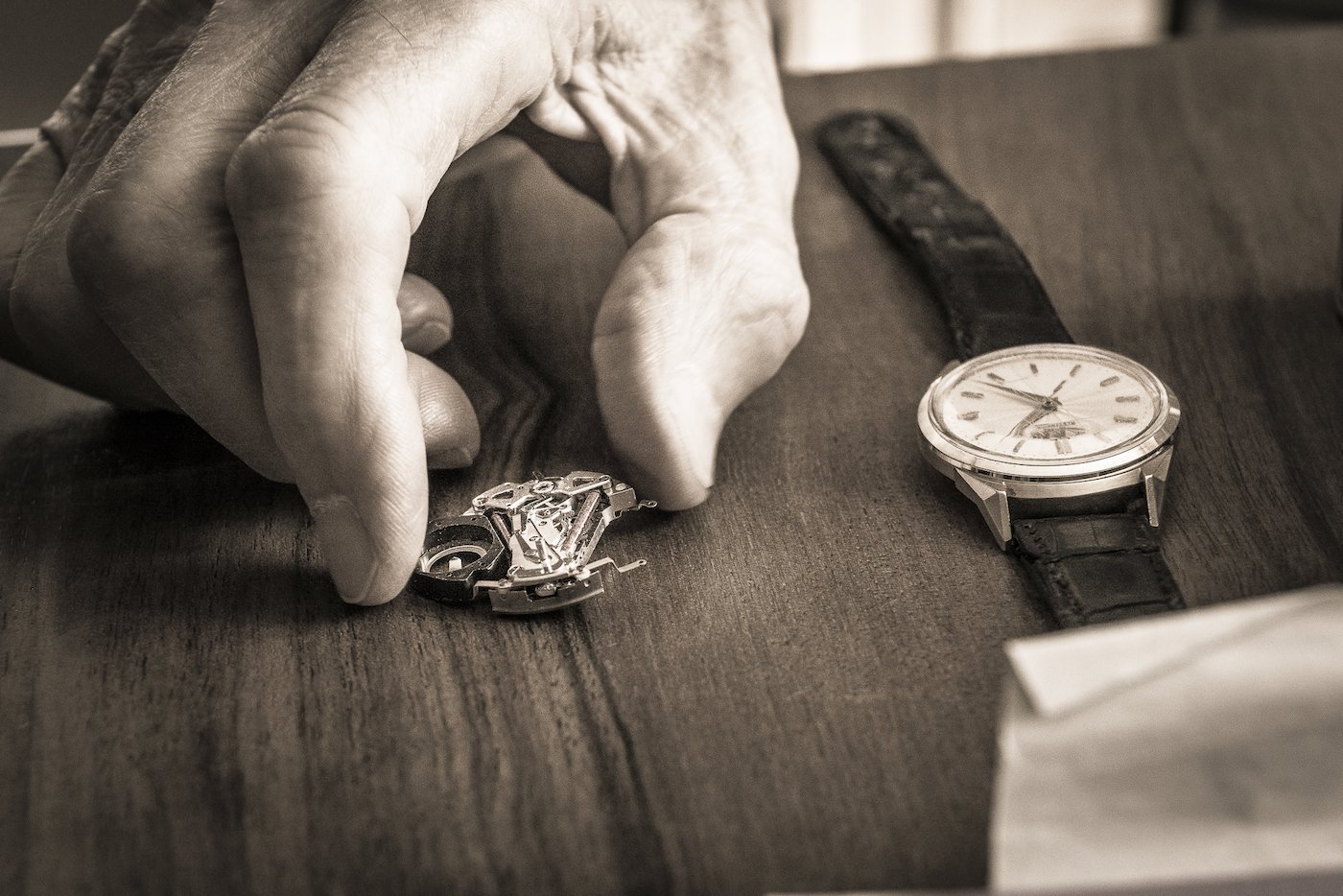t’s all there. The prototypes, the original components. The first attempts at a miniaturised battery. The drawings, of course. As pristine as the day they were made, by hand using a mechanical pencil, filed away in a cardboard folder since... 1964.
That was the year, after a decade of service, that Jean Pommier quit Lip, exasperated by founder Fred Lip’s irascibility. He left with his memories, his cheery disposition and, most importantly, the extraordinary and unprecedented beginnings of the first electric Lip watch. Now retired and living in the south of France, Jean Pommier looks back at the events from six decades ago with an acuity and enthusiasm that belie his 97 years.
-

- At the age of 97, Jean Pommier talked at length about his career and how he developed the movement for Lip’s electric watch.
Meticulous
When we arrived at his home, last September, he had everything ready and waiting. The various folders were neatly stacked on the dining-room table, their pages barely yellowed. Next to them, a pile of science magazines. At almost 100 years old, Jean Pommier is reading up on nuclear fusion.
Behind him was a clock. The case was a little rough around the edges but inside was an authentic weight-driven movement, built in the early days of Louis XV’s reign. A piece that many a museum would love to have in its collection. Though he may refute it, horology is ingrained in him.

A complicated childhood
For a boy born in the 1920s, with dyslexia, Jean Pommier’s young years were far from rosy, with few means and endless hard work and effort for next to no results, because of the handicap nature had given him. He came out of it determined to prove life wrong, capable of knuckling down and, most of all, with the ingenuity to overcome whatever challenge stood in his way.
His father could see he was bright. Unable to pay for studies for both his children, he decided to pin his hopes on Jean, who was clearly a quick thinker and good with his hands.
Next stop would be Besançon, its watchmaking school, then an engineering diploma. Without the weight of reading and writing hanging over him, the young man outshone his classmates, astonishing everyone with his grades.
A “troublesome reputation”
As a husband and father of two in the 1950s, Jean Pommier was struggling to make ends meet with his first job in the arms industry. A vacancy at Lip took him back to Besançon. “They were paying twice what I was earning! I said yes straight away, despite what I’d heard about Lip and its troublesome reputation.”
He was catapulted head of production methods which, he was told, included optimisation of the assembly process. Translation: Lip, which had thus far focused on small series, wanted to step up the rate of production, with an objective of 12,000 to 15,000 watches a day: almost eight times the volume then.
The company believed it had the means to succeed, employing thousands and boasting an assembly line… that didn’t work. “I was put in charge [of the assembly line] which turned out to be a curse in disguise. Still, I managed to get it running then optimised. They were using the wrong metals and escapements were still being adjusted one by one, by hand, with only five qualified watchmakers to do it. I set up a novel projection system for pre-adjusting the escapements and controlling parts, after which only simple manual adjustment was required.”

Electricity in the air
Jean Pommier’s system, which was operating at full capacity, had the advantage of being flexible and modular. Designed for the R25 calibre, it was easily adapted to the R23, then its numerous offspring. Behind the scenes, however, the young engineer had been given something else to work on. An idea on which Lip set great store: the electric watch.
The team tasked with this avant-garde project was as hybrid as the movement itself, which combined a conventional mechanism with a battery and coil. The objective wasn’t so much to confirm that the (relatively simple) calibre functioned, but how to miniaturise and mass-produce it.
To do so, Lip entered into a partnership with the American Elgin, which had been working on the subject since 1939, later joined by Hamilton and Bulova. The project implied an enormous amount of R&D and Lip made one mistake: “They wanted to manufacture the battery themselves. Because they knew how to make small parts, they thought that making a small battery would be well within their capabilities. Except we’re not talking about the same thing. A battery is chemistry, electric current, high-precision conductors. It’s a different profession entirely.”

No going back
Lip was ready to throw in the towel… only it wasn’t that simple: news of “Lip’s electric watch” had already been announced. And one had been presented to General de Gaulle. “Two, actually,” says Jean Pommier. “A great publicity stunt. The battery didn’t last long and the movement didn’t run well. Whenever the General’s watch stopped, he was given a second one to wear while the other was taken back to be serviced.”
Another poisoned chalice: with no dedicated resources, Jean Pommier now had to foolproof a watch he hadn’t designed, that didn’t work and which still had to be released because Lip had said it would be.
A gold 4 CV
Ever the diplomat, Jean Pommier sensed he couldn’t scrap the whole thing and start afresh, despite the fact “it would have been much simpler.” Instead, he drew up a three-point battle plan, starting with a replacement battery. He shopped around and settled on a US brand, Union Carbide, and its compact, long-life Eveready 201.
Next he redesigned the calibre, positioning the battery at a slight angle (something which had never been done before) to free up height in the movement’s centre. Lastly, he made changes to the electric circuit. “You need perfect solders with a weak current. I did mine in gold and it worked.”
Enter Calibre R27 and with it the electric watch, which Lip went on to produce in considerable numbers. Jean Pommier was given one in gold: “It was worth as much as a Renault 4 CV!”.

Tensions
Despite this success, his relationship with Fred Lip was fast deteriorating. The head of the company hadn’t seen fit to present him personally with the gold R27, sending one of his subordinates instead - which Jean Pommier hadn’t appreciated. The grudge became deeper some time later when the same Fred Lip had him sign a document relinquishing intellectual property rights. The R27 he’d developed was no longer his.
Lip ramped up production but failed to follow through with the necessary technical and financial means. Arriving at the factory one morning, Jean Pommier learned, almost by chance, that he was appointed production manager. Yet another “promotion” he could have done without: his new position came with ambitious objectives but nothing in the way of budget, human or technical resources.
“Regards, all the same”
Jean Pommier saw problems ahead: some of the machines were of another era. “One dated back to the German occupation. It hadn’t worked for six months when I was finally given permission to send it back to the manufacturer for repair. When it arrived at their workshop in Switzerland, they called and asked if it was for scrap.”
Jean Pommier shared his concerns with management. On April 29, 1963, he received an extraordinary letter, “dictated by Fred Lip before he left,” in which the entrepreneur, in the most vitriolic terms, reproached his production manager for “indulging in philosophical cogitations on the difficulties of watch manufacturing.”
In the same paragraph, Fred Lip insisted he “saw no valid reason” for delays, noting nonetheless that Jean Pommier had alerted him to problems with “supplies”, “blanks” and “absenteeism”. If that wasn’t enough of a contradiction, he accused the man who had given the company a reliable electric movement of living in an “outdated past,” signing off with a crude “enough, Pommier. (...) Regards, all the same.”
Jean Pommier left Lip the following year, taking his two best watchmakers with him (and getting them new jobs at Kelton). He also took with him drawings for a project he’d been working on in secret, to miniaturise the R27, which would have enabled Lip to rapidly release a version of its electric watch for women. The company went on to experience the most violent worker-management conflict the industry had ever known. As for Jean Pommier, in 2022 he was granted a patent for a lost-beat escapement. At 96 years of age.

































